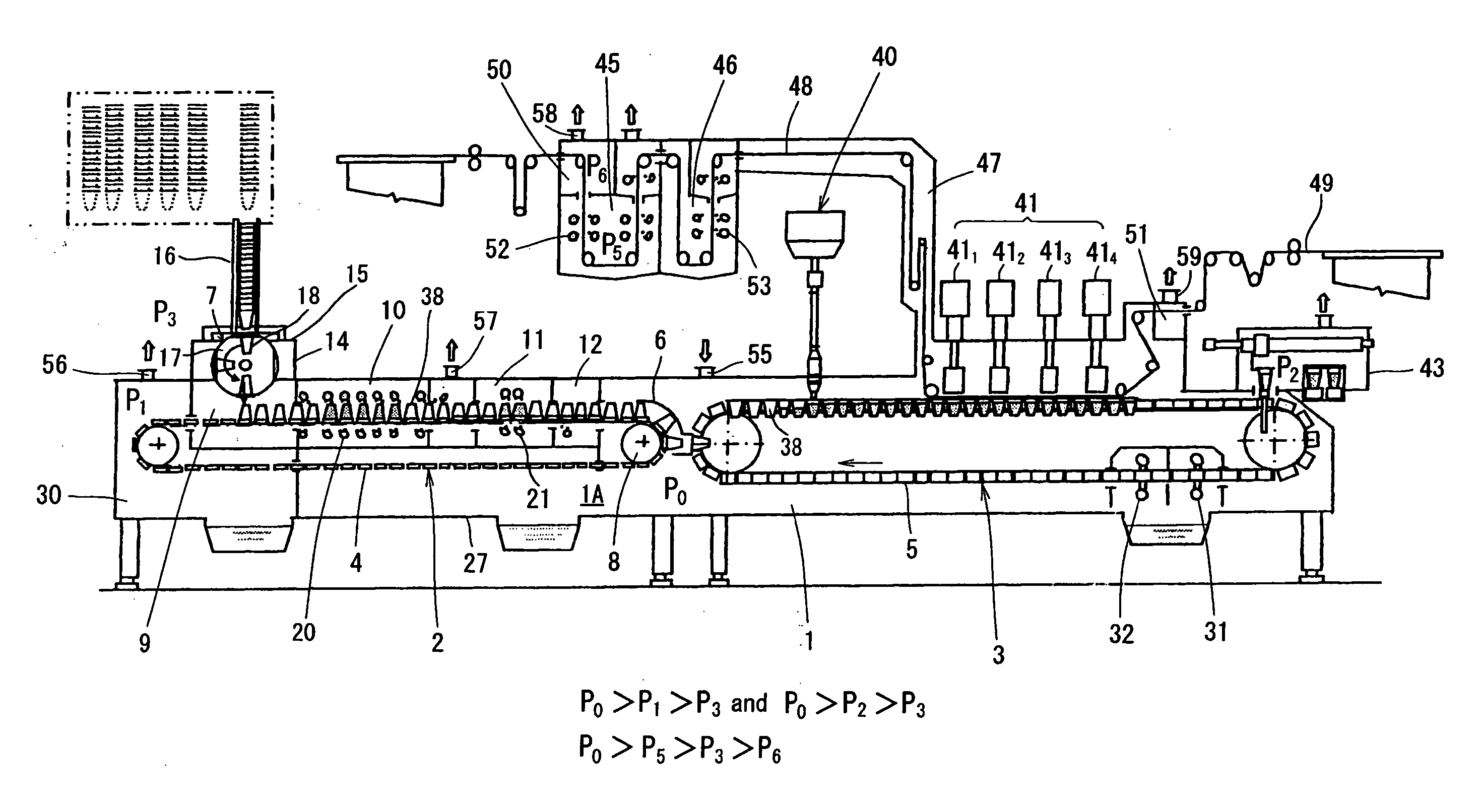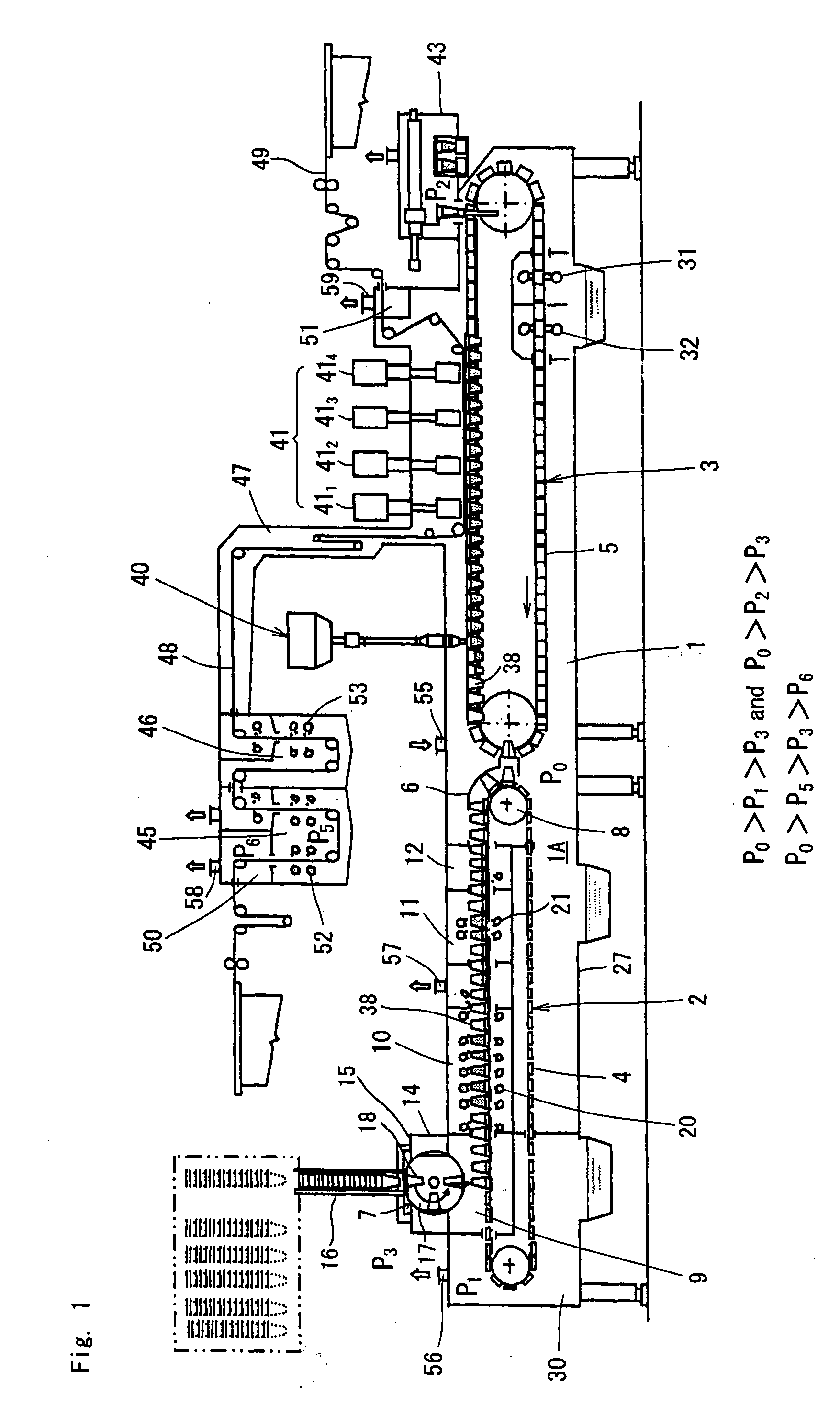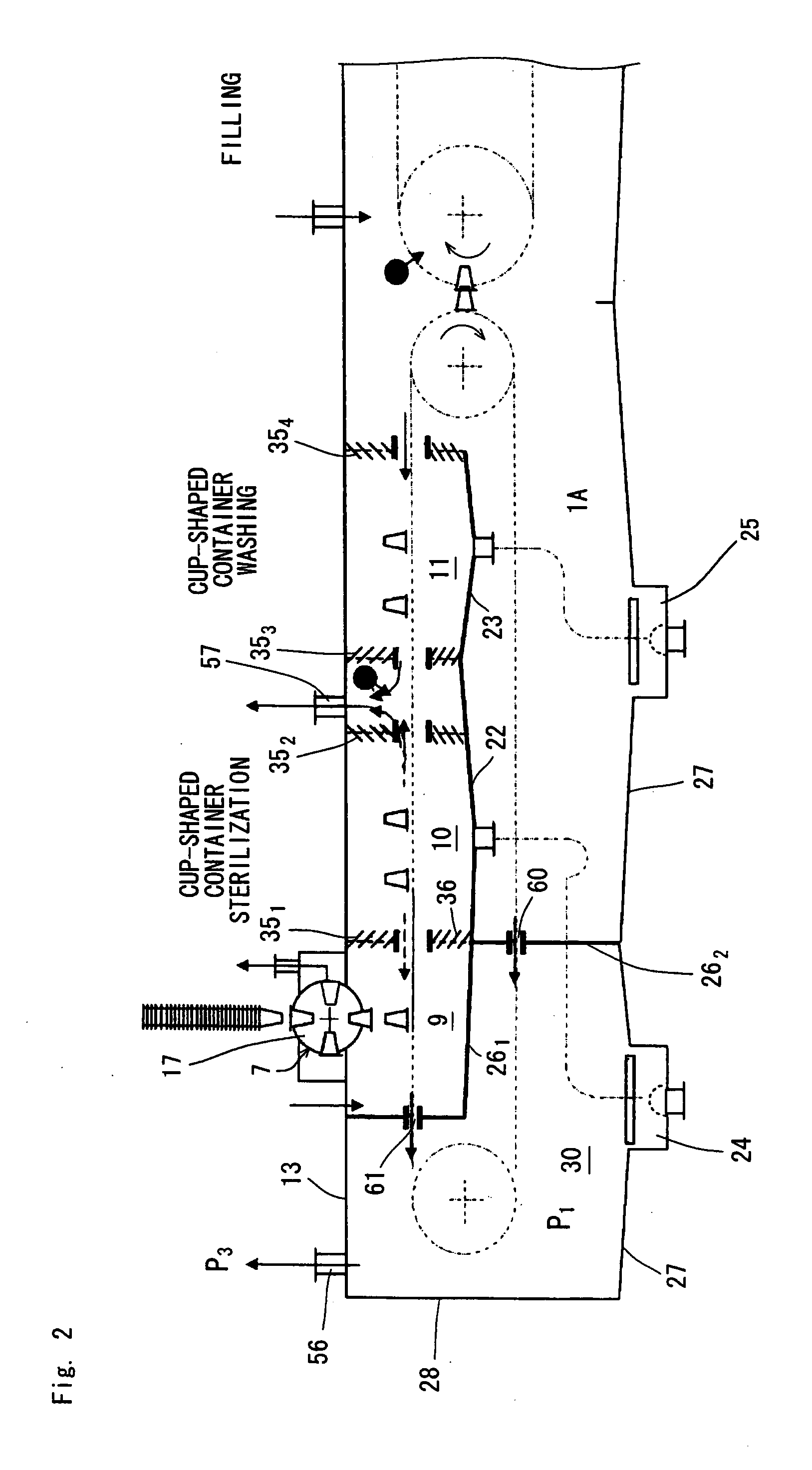[0021] With the sterilization and filling method and apparatus for cup-shaped containers in accordance with the present invention, conveying the container from a container sterilization process to a container washing process and conveying the container from a filling process to a sealing process are performed with respectively different conveyors disposed in series in substantially the same plane inside an integrated chamber and the conversion and transfer from the inverted state to the upright state are performed inside the chamber under the same pressure. Therefore, the sterilized containers can be transferred with good stability to the conveyor of the filling and sealing line located in the sealed chamber, even when lightweight cup-shaped containers are used. Furthermore, because the sterilization and washing are performed in an inverted state of the containers, reliable sterilization can be performed without the danger of the sterilization agent remaining in the container even when the sprayed quantity of the sterilization agent is large. By providing a preliminary pressure zone in front of the main air
discharge port, decreasing the air pressure of the preliminary pressure zone to below that in the chamber and above the external
gas pressure, thereby controlling the direction of air flow inside the chamber, the penetration of the external air into the chamber can be effectively prevented. Furthermore, although the container sterilization zone and container washing zone are provided in the same chamber as the filling and sealing zone, because the air flow can be directed toward the preliminary pressure zone, droplets or
odor of the sterilization agent do not diffuse to the filling zone and adhesion thereof to the contents is prevented.
[0022] By partitioning the container sterilization zone and container washing zone where the container sterilization process and container washing process are implemented with a blind-type partition, a uniform air pressure can be maintained inside the chamber, while preventing the liquids scattered in the container sterilization zone and container washing zone from being scattered to the other zones and the containers can be transported with good stability even if a container is omitted. In particular, when the container is conveyed in an inverted state, because it is conveyed by merely engaging the
flange portion of the container, by contrast with conveying in the upright state when the container is fitted with a
retainer, a lightweight container can become unstable due to air flow turbulence, but when the zones are partitioned in the above-described manner with a blind-type partition, the air flow turbulence is small, whereby a significant positive effect is produced on stable conveying of the containers. Furthermore, when the cup-shaped containers are made from a
polyester resin such as PET, by spraying a
peracetic acid solution on at least the inner surface of the container in an inverted state, the effective sterilization can be conducted without the risk of causing the adhesion of odor to the containers or
thermal deformation of the container as in the conventional systems.
[0023] In the sterilization apparatus in accordance with the present invention, the first conveyor and second conveyor are disposed in the same chamber. Therefore, the apparatus structure can be simplified. In particular, the mechanism for reversing the cup-shaped container from the inverted state into the upright state can be greatly simplified by comparison with the conventional mechanisms, the sterilization of the apparatus is facilitated, and the structure is advantageous for maintaining the most significant level of washing in the aseptic sterilization structure.
[0024] Further, configuring the container supply device as described in claim 13 is effective in reducing the outflow of air in the aseptic chamber and containing the sterilization agent odor to the outside through the container supply port. Moreover, by employing a configuration in which the lid material sterilization zone and lid material washing zone can be controlled to an air pressure different from the air pressure inside the aseptic chamber, the outflow of air contained in the aseptic chamber through the lid material passage hole can be minimized and the inside of the aseptic chamber can be maintained efficiently in an aseptic state. Further, by employing a configuration in which a container
discharge pressure regulation chamber is provided and the air pressure inside the container
discharge pressure regulation chamber and aseptic chamber can be controlled independently, it is possible to minimize the outflow of air contained inside the aseptic chamber through a port for discharging the containers into the aseptic chamber and to control the flow direction of the air inside the aseptic chamber. By controlling the air pressure in each zone, from the air pressure inside the aseptic chamber to the external air pressure, in a stepwise matter with the aforementioned pressure regulation functions, the aseptic level of the aseptic chamber can be reliably maintained and flow direction of air inside the chamber can be controlled. Furthermore, the outflow of air from the aseptic chamber can be minimized and the amount of aseptic air that has to be supplied to maintain the
positive pressure can be reduced. Further, by partitioning the chamber with the partition wall in the transfer site between the first conveyor and second conveyor, the droplets or odor of the sterilization agent can be effectively prevented from penetrating from the sterilization-washing zone into the filling-sealing zone and a better aseptically filled product can be obtained. The above-described sterilization and filling method and apparatus of the cup-shaped container in accordance with the present invention are not limited to aseptic filling and are also applicable to chilled filling, hot packing, and the like, but the most desirable application thereof is for aseptic filling. The beverage sealed in a cup-shaped container that is obtained with the aseptic filling method in accordance with the present invention enables filling and sealing with a high degree of sterilization even when the beverage sealed in the cup-shaped container is a beverage that can be easily spoiled, such as a low-acidity beverage, that conventionally required chilled distribution. Therefore, after the production, the multiplication of
bacteria is prevented over a long period even at normal temperature, normal-temperature distribution is possible, and distribution cost can be reduced.
 Login to View More
Login to View More 


